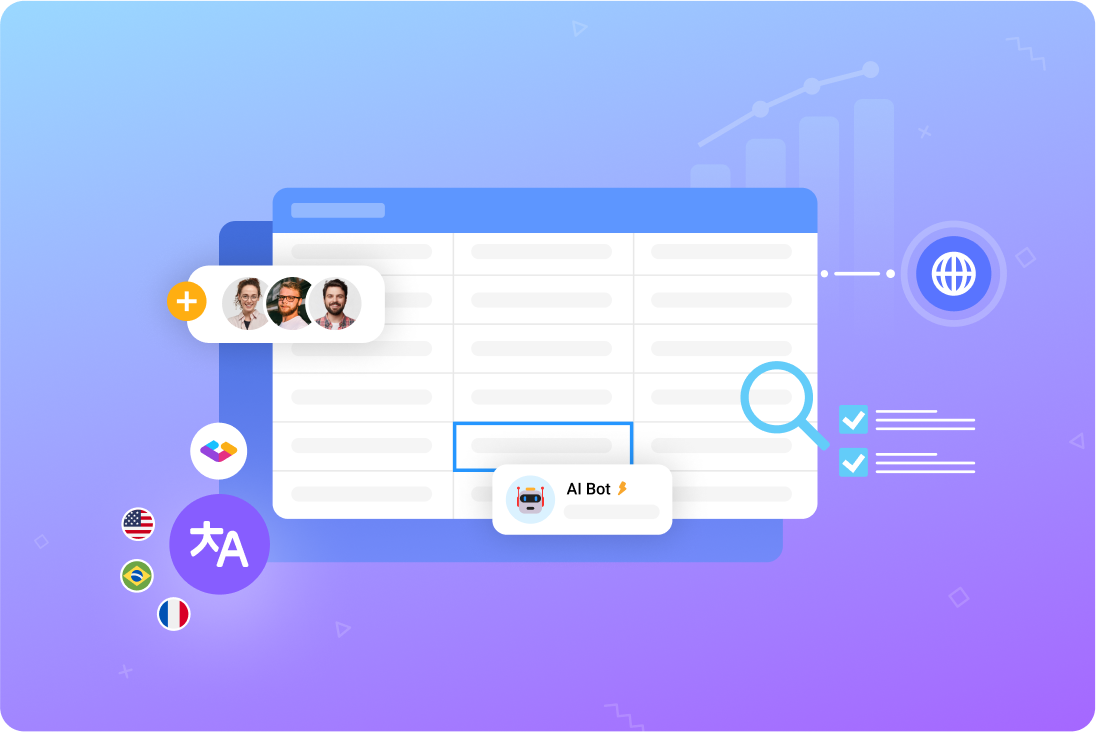What makes a system scalable?
Scalability is the ability of a system or process to smoothly accommodate growth. Many scalable processes share a definable set of characteristics:
- Reliability: A scalable process is finely honed so that it can be trusted to generate the required outputs, regardless of scope.
- Resilience: Scalability requires that your process be able to withstand increased stress and volume without collapsing.
- Efficiency: Every aspect of a scalable process should maximize output while minimizing wasted time, money, and effort.
- Flexibility: Scalability is all about growth. Should your growth strategy change, a scalable process will be able to adapt.
Read on to discover how to apply these principles to your localization workflow and create a scalable localization process that’s more than capable of fulfilling your organization’s goals.
1. State your purpose: why are you localizing?
Far too often, companies rush headlong into localization without a clear understanding of why they’re doing it. This approach leads to a chaotic workflow and unpredictable results — the opposite of what you’re looking for in a scalable localization strategy.
Set goals
First, establish quantifiable goals with key performance indicators (KPIs) so that all stakeholders are on the same page. Are you trying to drive sales, reduce website bounce rates, improve app installs, increase customer retention, or something else?
Identify target markets
Then, identify your target markets and define the benefits and risks of serving them. Who are your potential customers, and how does your product or service help them? Who are your regional competitors, and why is your product or service a better fit? Can localization give you a boost in any underperforming markets you currently serve?
Select languages
With your growth strategy laid out, assemble the language portfolio needed to realize your goals. Remember that languages aren’t uniformly spoken in all regions — for example, Spanish in Spain can vary widely from the Spanish spoken across Latin America. Meanwhile, Mandarin is written differently in mainland China and Taiwan.
Set limits
Establish your budget, resources, scope, and timeline. The nature of your business, along with your growth goals and target markets, should give you an idea of what you’ll need to localize. Prioritize goals to most effectively allocate available budget and resources. Consider the ROI of each market: where will your resources go the furthest?
Time constraints can also limit your localization efforts. Human translation and machine translation won’t yield the same quality, but the latter is much faster — and in some cases, it may be sufficient for your needs.
2. Internationalize everything
Internationalization is the process of designing an app so that it’s ready to be localized without requiring additional coding. Good internationalization boosts your localization strategy and makes it much easier to scale.
Rather than hard-coding text strings, smart developers use variables and tokens in their code to represent language-specific content. Hard-coded text is one of the most common localization roadblocks for developers, and variables are the answer.
Learn more about string translation
Apply the principles of app internationalization to all your content. For example, if your budget can’t accommodate new localized graphics, solve this problem in advance. Use textless images as much as possible, keep your visuals free of specific cultural references, and check that you aren’t breaking any region-specific taboos.
3. Centralize your localization personnel
Structure your localization staff in one team to improve coherency and remove barriers to communication and collaboration. Siloed teams will quickly become difficult to coordinate. Avoid splintering your workforce and organize localization personnel under one umbrella.

Establish a clear team structure, often headed by a localization manager, and assign explicit ownership over responsibilities and outcomes. Decide whether to host this squad in-house or partner with external localization service providers (LSPs) — or blend both with a small in-house team for high-priority markets while outsourcing other content.
Internal localization
In-house teams can function as either a standalone unit or as a subdivision of another department.
Pros
- High degree of familiarity with your brand, products, and services as well as company processes and culture.
- Easy access to relevant data and other colleagues who can help when needed.
- Greater oversight over the localization workflow.
Cons
- More salaries and overhead costs.
- May be difficult to recruit specialists with in-demand regional and linguistic expertise.
- Internal teams may struggle to keep pace with sudden rapid growth.
External localization
LSPs bring trained specialists with proven expertise in their respective markets and languages.
Pros
- No need to recruit and train a team of in-house experts.
- Gain the benefits of external perspectives and experiences.
Cons
- Less control over quality and deadlines.
- Limited opportunity for collaboration across teams.
If you outsource, maintain at least one in-house reviewer per market for effective quality control. Protect yourself against unforeseen delays or other issues with redundancy — don’t limit yourself to just one provider.
Learn more about localization quality assurance
4. Build a streamlined localization environment
A smooth process is a scalable one. Mastering your next localization project is all about empowering your team with the tools and processes they need to deliver their best work. Create a localization environment that engenders seamless collaboration, automates as much as possible, and minimizes manual labor.
Your content management platform is the cornerstone of your localization pipeline and content ecosystem. Sometimes you’ll see this also referred to as a translation management system (TMS). It’s where you’ll store all your localized content, manage your project statuses, and track the overall progress of your localization effort.
Learn more about managing content at scale
Shape your ecosystem around a localization tool that increases efficiency
The right content management platform is essential for creating a scalable localization pipeline. Here’s what to look for:
- Integrations: Translators, localization managers, testers, and developers will be constantly passing content around during the localization process. Eliminate manual importing and exporting via integrations with your preferred software development platforms and CAT tools.
- Status tracking: Automatic status tracking helps translators prioritize their work while showing you at a glance exactly how your project is going. Gridly offers five ways to track localization statuses across your projects.
- Multiple content types: You won’t just be localizing text, even if that’s where you’re starting out. Images, audio files, and even video and gifs may need to be localized as well. Choose a content platform that can host all these media types and more so your team can access everything they need from one convenient location.
- Access control: Managing data access is crucial for minimizing errors and unwanted changes. Gridly solves this challenge with Views: customizable workspaces that give each team member access only to the content they need.
- Version control: When all your work happens in one space — or if you’re dealing with one Excel sheet after another — it can be hard to track and manage changes to preserve a single source of truth. Branching allows localization writers to experiment and try things out, then merge their content into the master branch only when it’s been checked and approved.
- String ID management: Your content management platform will use a string ID to identify each string of text. Look for one that enforces ID uniqueness, as duplicate IDs can cause problems when text is pushed to your app or game.
- Ease of use: A feature-rich content management platform will still bog down your pipeline if it’s difficult to use. Gridly’s intuitive spreadsheet interface is instantly recognizable to anyone who’s ever used Excel or Google Sheets for localization.
Learn more about how Gridly can streamline your localization pipeline
Learn how to create an agile localization workflow
5. Create an agile localization workflow
As your localization drive scales, minor inefficiencies can quickly become massive blockers. While a standard step-by-step localization process — known as waterfall localization — can lead to long wait times at the slightest hiccup, an agile localization workflow enables you to sidestep obstacles by localizing on an ongoing basis.

This is where your centralized team and localization environment come together in seamless harmony. Localization managers track statues and assign tasks, translators submit localized content, testers perform quality checks, finalized content is pushed right into the development platform, and users provide feedback — and all of this happens at the same time.
Learn how to create an agile localization workflow
6. Maintain strict quality control
Stay ahead of potential roadblocks by proofing your localization workflow against quality issues. Mistakes happen — but when you prepare for them in advance, they won’t get in your way.
Many teams make the mistake of saving localization quality assurance (LQA) for the end, if they find time for it at all. But you can maintain quality from the very start with a quality-driven approach to localization.
Create a style guide
A style guide tells writers how your brand communicates. With tone and voice guidelines, grammar and formatting rules, buyer personas, and other useful information, a good style guide keeps writers on-brand and helps them get their content right the first time.
Use translation memories and localization glossaries
Translation memory (TM) is a CAT tool feature that helps translators work faster and more accurately with a database of previously-used translations. When an entry in your TM appears again in your content, the CAT tool will prompt the translator to reuse the approved translation.
Meanwhile, a localization glossary is a database of frequently-used terms or phrases along with approved translations, context, or definitions. This information speeds up the translation process and enables writers to create more effective localized content.
Set clear quality standards
Clear quality expectations keep everybody accountable. Define your standards for translation accuracy, audio timing, and sound quality. Ensure any external partners are performing their own localization QA before submitting finished content back to you.
Choose an LQA model
An LQA model defines error categories so testers can quickly label bugs, grade them by severity, and assign them to the correct personnel for speedy follow-up. Categories may include translation errors, display problems, style guide conflicts, and other similar issues.
In Gridly, testers report bugs by attaching tickets to any cell containing an error. Gridly natively supports a wide range of LQA models — just choose the one that best fits your needs. A good localization content management platform will streamline your LQA process and include testers in your agile localization workflow without requiring extra steps or tools.
The right localization platform is the cornerstone to a scalable localization process
A scalable localization process is all about efficiency. Keeping costs down, reducing errors and delays, reacting to setbacks, and handling a growing workload — an efficient workflow does all this and more.
At the core of a successful localization pipeline is a flexible content management platform that centralizes your workflow and empowers each member of the team to deliver their best work with minimal distractions or obstacles. Find the right tool for your team, and you’ll be well on your way to creating the scalable localization strategy your growing organization needs.
Ready to get started? Try Gridly today.
Learn more about how Gridly can enhance your workflow










